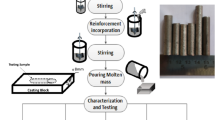Abstract
Lightweight laminated composites containing a ceramic front layer and a metallic backing layer were used in order to protect people, moving equipment, and mobile vehicles from high velocity impact and the increased mobility of mobile vehicles. In this study, by adding10 vol% SiC and 500 ppm MgO nanoscale particles on the microstructure of Al 2 O 3 matrix and applying optimum sintering conditions, ceramic performance against high-speed projectile impact was improved. To perform this investigation, a number of target samples with two different types of front layers (alumina and Al 2 O 3-SiC-MgO nanocomposite ceramic) were produced. Impact tests were conducted on these samples using 7.62 mm projectiles with a velocity of 820 ± 15 m/s. The amount of bulge and bending of the backing layer caused by impact tests was measured. The results of the impact tests on the samples made of Al 2 O 3-SiC-MgO nanocomposite ceramics and alumina were also compared and analyzed. The results indicate that the substitution of Al 2 O 3-SiC-MgO ceramic layer — which is proffered in this paper — instead of pure alumina ceramic layer, decreases the areal-density of the samples by at least 30% and improves mechanical properties by about a 60% increase in flexural strength and 100% growth of the energy distribution factor, which impressively increases impact energy absorption.
Similar content being viewed by others
References
M. U. Beylia and R. O. Yıldırımb and B. O. Gelc, Investigation on the ballistic behavior of Al2O3/Al2024 laminated composites, J. Mater. Proc. Tech., 196 (2008) 356–364.
A. L. Florence, Interaction of projectiles and composite armour, part II, California: Standard Research Institute Menlo Park, 1969, AMMRC-CR-69-15.
R. L. Woodward, A simple one-dimensional approach to modeling ceramic composite armour defeat, Int. J. Impact. Eng, 9(4) (1990) 455–74.
D. Reijer PC. Impact on ceramic faced armours, PhD thesis, Delft University of Technology, 1991.
M. L. Wilkins, CF. Cline and CA. Honodel, Forth progress report of the light armor program, Livermore, CA: Lawrence Livermore National Laboratory, 1969, Report No. UCRL-50694.
W. J. Chung and M. Lee, Modeling high-speed impacts and explosions with ExLO code, J. Mech. Sci. Tech., 23 (2009) 2244–2252.
R. Zaera and V. Sanchez-Galvez, Analytical modeling of normal and oblique ballistic impact on ceramic/metal lightweight armours, Int. J. Impact Eng., 21(3) (1998) 133–48.
A. Tate, A theory for the deceleration of long rods after impact, J. Mech. Phys. Solids, 15 (1967) 387–99.
V. P. Alekseevskii, Penetration of a rod into a target at high velocity, Combustion, explosion and shock waves, vol. 2. New York, USA, Faraday Press (1966) 63–66.
C. Kaufmann, et al., Influence of material properties on the ballistic performance of ceramics for personal body armor, Shock Vibration, 10 (2003) 51–58.
K. Niihara, A. Nakahira, in: V. J. Tennery (Ed.), Strengthening of oxide ceramics by Sic and Si3N4 dispersions, Proceedings of the Third International Symposium on Ceramic Materials and Composites for Engines, American Ceramic Society, Westerville, OH (1988) 919–926.
K. Niihara, A. Nakahira, G. Sasaki and M. Hirabayashi, Fabrication and mechanical properties of 5 vol% copper dispersed alumina nanocomposite, Proceedings of the First MRS International Meeting on Advanced Materials, Materials Research Society, Pittsburgh, PA (1989) 129–134.
K. Niihara, New design concept of structural ceramicsceramic nanocomposites, J. Ceram. Soc. Japan, 99 (1991) 974–982.
A. S. Vanini et al., Physical and mechanical properties optimization of Al2O3-SiC with small amount of MgO, 12TH European Inter — Regional Conference On Ceramics-CIEC 12, Université de Mons, Belgium, 2010.
J. W. McCauley, A. Crowson, W. A. Gooch, Jr., A. M. Rajendran, S. J. Bless, K. V. logan, M. Normandia and S. Wax, Ceramic armor materials by design, American Ceramic Society, USA (2002).
Author information
Authors and Affiliations
Corresponding author
Additional information
This paper was recommended for publication in revised form by Associate Editor Mohammad Abdul Aziz Irfan
Ali Asadi received his BSc degree in mechanical engineering from the Tabriz University, in 1995 and his MSc degree in mechanical engineering from the Sharif University of Technology, in 1997. After that, he worked in impact and protection research center as a research assistant on protection systems against high velocity impact. He started his PhD thesis on “Stress wave propagation and experimental impact analysis on nanocomposite ceramic/metal lightweight targets” in the Department of Mechanical Engineering, at Amirkabir University of Technology (Tehran Polytechnic) in 2005 and finished it in 2011. His research interests include high velocity impact, nano ceramics, composite structures, stress wave propagation.
Ali Sadough Vanini is currently a full professor at Amirkabir University of Technology (Tehran Polytechnic), Mechanical Engineering Department. He received a doctoral degree in Metallurgy Engineering from Paris 6 (Pierre and Marie Curie) University France in 1985. Visiting Professor, Paris 6 University, France, June 1990–Sept 1990, Oct 1992–Sept 1993 and École Polytechnique de Montreal Canada Feb 2000–Feb 2001. Since 2000 he has also been the member of Centre of Excellence in Thermoelasticity and Director of the Materials Science and Biocompatibility Laboratory of Mech. Engin. Depart. Prof. Sadough Vanini is the author or coauthor of over 180 professional papers and books in the Materials and Mechanical Engineering fields.
Amin Jabbari received his BSc degree in mechanical engineering from Amirkabir University of Technology, in 2010. Getting first rank in national universities entrance exam, he started his MSc at the School of Mechanical Engineering, Amirkabir University of Technology. His research interests include fracture mechanics, mechanical behavior of nanocomposites, rheology, and semi-solid metal forming.
Rights and permissions
About this article
Cite this article
Asadi, A., Vanini, A.S. & Jabbari, A. Investigation on the impact behavior of Al 2 O 3-SiC-MgO nanoceramic/metal laminated composite. J Mech Sci Technol 25, 2179–2184 (2011). https://doi.org/10.1007/s12206-011-0535-4
Received:
Revised:
Accepted:
Published:
Issue Date:
DOI: https://doi.org/10.1007/s12206-011-0535-4




